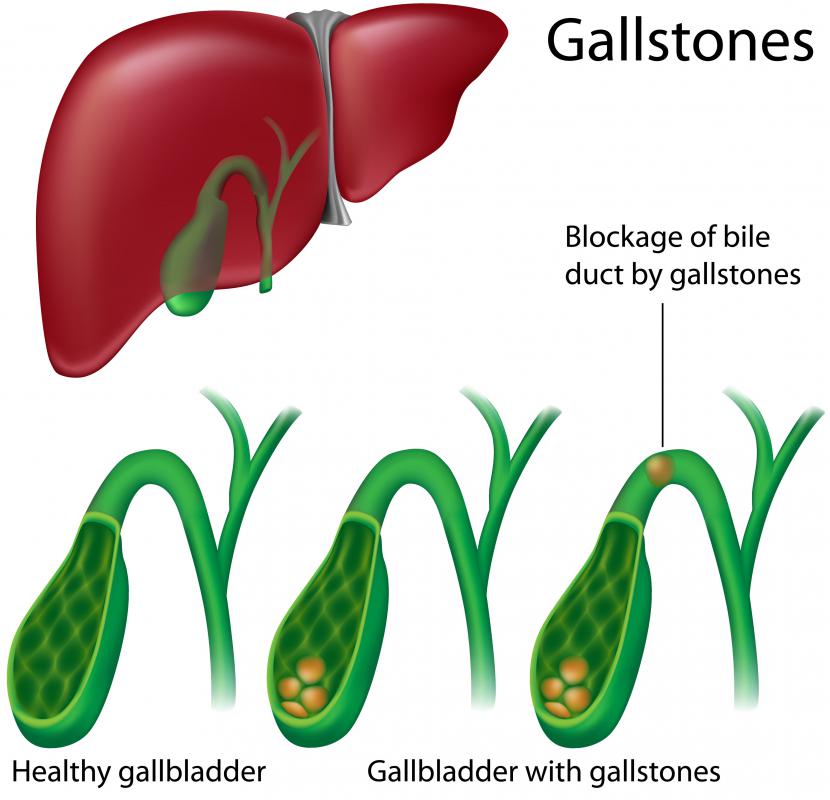At WiseGEEK, we're committed to delivering accurate, trustworthy information. Our expert-authored content is rigorously fact-checked and sourced from credible authorities. Discover how we uphold the highest standards in providing you with reliable knowledge.
What Are the Signs of a Gallbladder Attack?
The signs of a gallbladder attack are generally rather simple, but they may not be very easy to identify. Many of the symptoms for less-severe gallbladder problems are things that people may experience frequently for reasons that have nothing to do with serious illness, which can cause individuals to ignore the symptoms. The classic signs of a gallbladder attack include pain, mostly located just below an individual's ribs on the right-hand side, along with nausea, indigestion, and fever. Experts suggest that fever is the most dangerous sign because it could mean the gallbladder is severely blocked, which can be deadly if left untreated.
When people eat certain foods, their bodies produce bile to aid in digestion, and the gallbladder is the organ that does this. The main items that cause this reaction are nutrition sources with higher levels of fat, so these are also the foods that usually lead to signs of a gallbladder attack. In fact, experts suggest that if a person experiences any of the classic symptoms after eating foods high in fat, it is more likely that the individual's problems are actually related to the gallbladder.

Almost anything that causes inflammation in the gallbladder could lead to these symptoms. Most of the time, however, the symptoms are a sign that someone has gallstones. When the stones are fairly small, they will usually pass through a person's gallbladder without too much trouble, but as they get larger, it is more common for them to get stuck, which effectively blocks the gallbladder, leading to an attack.

Prior to actually showing signs of a gallbladder attack, many people experience a pattern of symptoms that are less severe and easier to ignore. For example, when people start developing gallbladder problems, some of them may experience bouts with less severe pain every time they eat certain foods. Other people may have constant gas or develop severe problems with constipation. Many people dismiss these symptoms, assuming they are a simply signs of normal digestive upset.

If a person starts having gallbladder problems, surgery is usually the only option. Generally speaking, the gallbladder is totally removed during the surgical procedure, which doctors generally perform using non-invasive techniques. Once the gallbladder is out, the recovery time is usually fairly rapid, except in rare cases where doctors are required to use more invasive methods. Experts suggest that people tend to get by just fine without a gallbladder, so there is generally no hesitation about removing it once the doctor realizes problems exist.
AS FEATURED ON:
AS FEATURED ON:














Discussion Comments
A girl I used to work with got a full-on gallbladder attack at work one morning. She was in the bathroom throwing up. It was really pitiful. She had surgery not long after that, but said the nausea was worse than morning sickness!
She did say she felt 100 percent better after her surgery, and was really glad she had it done. She said she didn't have night time nausea anymore. She said before the surgery, she was pretty much on a liquid diet and was still having problems, but since the surgery, she was eating a normal diet and feeling human again.
When my mom had gallbladder trouble, it was mostly indigestion and nausea. She gobbled antacids like candy, and they would help for a while, but then it came back. She went to her doctor and he ordered an ultrasound on her gallbladder and advised her that she needed to have it removed because it was full of stones.
Her surgery was laparascopic, so the recovery time was pretty quick, and her surgeon said her gallbladder actually had more in the way of what he termed "gravel" and "sludge" in it. He said there was only one real stone, but said it was pretty sludgy and needed to come out.
Post your comments